作者:桂。
时间:2017-04-21 21:11:23
链接:http://www.cnblogs.com/xingshansi/p/6743780.html

前言
看到最近大家都在用Tensorflow,一查才发现火的不行。想着入门看一看,Tensorflow使用手册第一篇是基于MNIST的手写数字识别的,用到softmax regression,而这个恰好与我正在看的《统计信号处理》相关。本文借此梳理一下:
1)罗杰斯特回归
2)Softmax Regression
3)基于Tensorflow的MNIST手写数字识别框架
内容为自己的学习记录,其中多有借鉴他人的地方,最后一并给出链接。
一、罗杰斯特回归(Logistic Regression)
A-问题描述
一般说的Logistic回归,是指二分类问题。
对于连续的变量X,如果说它服从Logistic回归,则:

对应概率密度以及分布函数:
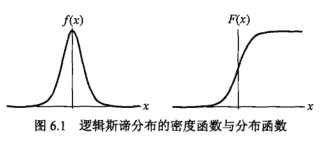
F(x)更像是一个threshold,f(x)的表达式也利于求导。
定义Logistic 回归模型:
 为输入,
为输入, 为对应输出,二项Logistic回归对应如下模型:
为对应输出,二项Logistic回归对应如下模型:

联系到之前写的感知机:
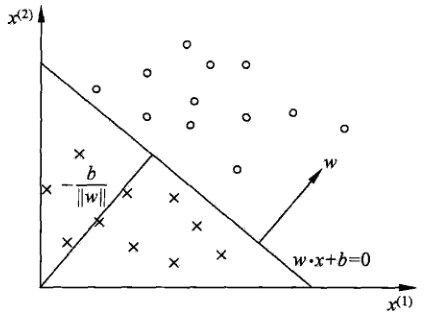
分类时,对应概率:
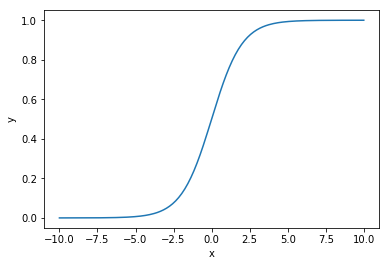
为正的概率大,为负的概率小,这个指数有点像把正/负→进行指数处理,这样就容易理解了。
有时为了表示方便,记: ,则表达式简化为:
,则表达式简化为:

为什了叫Logistic regression呢?

这样明显是一个线性回归的表达式。
B-理论分析
对于参数的求解,同感知机一样,就是求解w。利用最大似然求解:

定义sigmoid函数:

准则函数重新写为:
![]()
可以借助梯度下降或者牛顿法,这几个方法之前已经有过介绍。
利用求解得到的w,即可以进行概率判断,哪个概率大就判给哪个类别,整个思路与感知机也是一样的:

C-理论应用
用一个code说明其工作原理,还是借助之前感知器用的例子,因为Logistic回归可以认为是Softmax回归的特例,这里借用softmax框架给出对应代码:
%Logistic regression
clear all; close all; clc;
%Every category samples
N = 100;
X = [randn(N,2)+2*ones(N,2);...
randn(N,2)-2*ones(N,2)];
figure;
subplot 121
label = [ones(N,1);2*ones(N,1)];
plot(X(label==1,1),X(label==1,2),'b.');hold on;
plot(X(label==2,1),X(label==2,2),'r.');hold on;
%%Train
numClass = 2;
parm.learningRate = 0.5;
pram.iter = 5000;
parm.precost = 0;
X = [ones(size(X,1),1), X]';
[nfeatures, nsamples] = size(X);
W = zeros(nfeatures, numClass);
% 1, 2, 3 -> 001, 010, 100.
groundTruth = full(sparse(label, 1:nsamples, 1));
for i = 1:pram.iter
rsp = W'*X;
rsp = bsxfun(@minus, rsp, max(rsp, [], 1));
rsp = exp(rsp);
prob = bsxfun(@rdivide, rsp, sum(rsp));
% compute gradient based on current probability
grad = - X * (groundTruth - prob)' / nsamples ;
% update W
W(:,2:end) = W(:,2:end) - parm.learningRate * grad(:,2:end);
% compute cost
logProb = log(prob);
idx = sub2ind(size(logProb), label', 1:size(logProb, 2));
parm.cost = - sum(logProb(idx)) / nsamples;
if i~=0 && abs(parm.cost - parm.precost) / parm.cost <= 1e-4
break;
end
parm.precost = parm.cost;
end
%Predict
rsp = W' * X;
[~, prediction] = max(rsp, [], 1);
subplot 122
X = X(2:end,:)';
plot(X(prediction==1,1),X(prediction==1,2),'b.');hold on;
plot(X(prediction==2,1),X(prediction==2,2),'r.');hold on;
x = -5:.1:5;
b = W(1,2);
y = -W(2,2)/W(3,2)*x-b/W(3,2);
plot(x,y,'k','linewidth',2);
对应结果图:
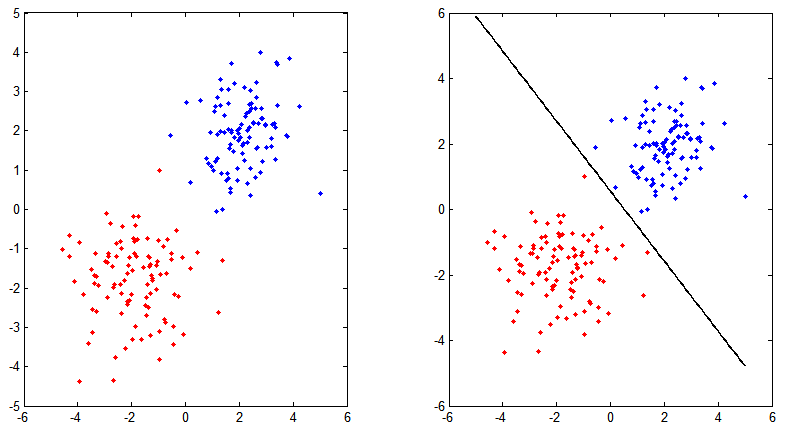
二、Softmax 回归
Logistic回归分析的是两类,对于多类的情形,通常称为:Softmax 回归。基于概率所以soft,概率中最大值所以Max。

其实这个式子可以理解为Y=K时,$w_k*x = 0$,上面式子可以表述为,为了与下面表述一致,这里w改为$ heta$表示:

假设样本个数为m,同logistic回归类似,Softmax准则函数可以写为:

进一步写为:

思路同Logistic回归,同样利用梯度下降/牛顿-Rapson可以求解。求解出w:
![]()
其中,

分类的思路与Logistic回归也是完全一致。另外在求解的时候,可以发现:
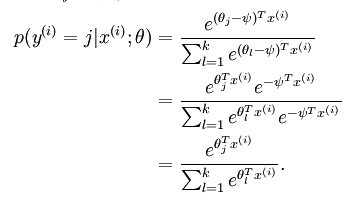
求解的时候,都减去一个数,是不影响结果的。前面提到Y=K时,$w_k*x = 0$,其实有一个为零就行,哪一类是无所谓的,所以优化只优化K-1,给出代码:
%Test Softmax Regression
clear all; close all; clc;
N = 100;
X = [randn(N,2)+5*ones(N,2);...
randn(N,2)-1*ones(N,2);...
randn(N,2)-4*ones(N,2)];
figure;
subplot 121
label = [ones(N,1);2*ones(N,1);3*ones(N,1)];
plot(X(label==1,1),X(label==1,2),'b.');hold on;
plot(X(label==2,1),X(label==2,2),'r.');hold on;
plot(X(label==3,1),X(label==3,2),'k.');hold on;
title('Orignal Data')
%%Train
numClass = 3;
learningRate = 0.5;
X = [ones(size(X,1),1), X]';
[nfeatures, nsamples] = size(X);
W = zeros(nfeatures, numClass);
% 1, 2, 3 -> 001, 010, 100.
groundTruth = full(sparse(label, 1:nsamples, 1));
iter = 5000;
precost = 0;
for i = 1:iter
rsp = W'*X;
rsp = bsxfun(@minus, rsp, max(rsp, [], 1));
rsp = exp(rsp);
prob = bsxfun(@rdivide, rsp, sum(rsp));
% compute gradient based on current probability
grad = - X * (groundTruth - prob)' / nsamples ;
% update W
W(:,2:end) = W(:,2:end) - learningRate * grad(:,2:end);
% compute cost
logProb = log(prob);
idx = sub2ind(size(logProb), label', 1:size(logProb, 2));
cost = - sum(logProb(idx)) / nsamples;
if i~=0 && abs(cost - precost) / cost <= 1e-4
break;
end
precost = cost;
end
%Predict
rsp = W' * X;
[~, prediction] = max(rsp, [], 1);
subplot 122
X = X(2:end,:)';
plot(X(prediction==1,1),X(prediction==1,2),'b.');hold on;
plot(X(prediction==2,1),X(prediction==2,2),'r.');hold on;
plot(X(prediction==3,1),X(prediction==3,2),'k.');hold on;
title('Prediction')
对应结果(线性可分时,结果正确,线性不可分时,边界点容易出现错误,如下图):

而实际应用中,我们不愿将任何一个$ heta$直接置零,而是保留所有 ,但此时我们需要对代价函数做一个改动:加入权重衰减。准则函数变为:
,但此时我们需要对代价函数做一个改动:加入权重衰减。准则函数变为:

这个时候只要将上面对应的code按如下修改即可:
grad = - X * (groundTruth - prob)' / nsamples +.02 * W;%lamdba = 0.02
% grad = - X * (groundTruth - prob)' / nsamples ;
% update W
% W(:,2:end) = W(:,2:end) - learningRate * grad(:,2:end);
W = W - learningRate * grad;
三、基于Tensorflow的MNIST手写数字识别
MNIST数据库是一个手写数字识别数据库,
MNIST(Mixed National Institude of Standards and Technology database),由几万张图片组成,其中每个照片像素为28*28(在读取时已经被拉成28*28=784的向量了),训练数据集train:55000个样本,验证数据集validation:5000个样本,测试数据集:10000个样本。
首先分别读取训练和测试数据:
import numpy as np
import matplotlib.pyplot as plt
from tensorflow.examples.tutorials.mnist import input_data
mnist = input_data.read_data_sets("MNIST_data/", one_hot=True)
先看看数据长什么样,任意读取一张图片:
#imshow data imgTol = mnist.train.images img = np.reshape(imgTol[1,:],[28,28]) plt.imshow(img)
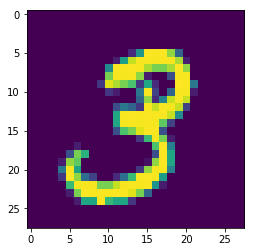
大概就是这个样子(其实是个gray图).
下面开始对数据进行基于Softmax Regression的处理。
首先创建一个会话(session),为什么需要创建session可以参考Tensorflow基本用法:
import tensorflow as tf sess = tf.InteractiveSession()
通过为输入图像和目标输出类别创建节点,来开始构建计算图:
sess = tf.InteractiveSession()
x = tf.placeholder("float", shape=[None, 784])
y_ = tf.placeholder("float", shape=[None, 10])
其中'None'表示该维度大小不指定。
我们现在为模型定义权重W和偏置b。可以将它们当作额外的输入量,但是TensorFlow有一个更好的处理方式:变量。一个变量代表着TensorFlow计算图中的一个值,能够在计算过程中使用,甚至进行修改。在机器学习的应用过程中,模型参数一般用Variable来表示:
W = tf.Variable(tf.zeros([784,10])) b = tf.Variable(tf.zeros([10]))
变量需要通过seesion初始化后,才能在session中使用。这一初始化步骤为,为初始值指定具体值(本例当中是全为零),并将其分配给每个变量,可以一次性为所有变量完成此操作:
sess.run(tf.initialize_all_variables())
初始化完成后,接下来可以实现Softmax Regression了:
y = tf.nn.softmax(tf.matmul(x,W) + b)
softmax是tf.nn下的一个函数,tf.nn包含了很多神经网络的组件,tf.matmul在tensorflow里的意义是矩阵相乘。给出损失函数(交叉熵):

交叉熵没听过其实也不要紧,Maximum Likelihood(ML, 最大似然)估计应该都知道吧?

其中N为样本总数,且![]()
我们频数以及频率是观测得到的,如何估计概率呢?我们通常用最大似然:

如果变形一下呢?同除以N:

最大似然估计不就是最小交叉熵估计?另一方面,交叉熵对误差的衡量类似联合概率密度的作用。给出对应code:
cross_entropy = -tf.reduce_sum(y_*tf.log(y))
reduce.sum为求和,reduce.mean为求取均值。有了准则函数以及理论框架,利用梯度下降进行训练:
train_step = tf.train.GradientDescentOptimizer(0.01).minimize(cross_entropy)
这里利用小批量梯度mini-batch下降,batch = 50个训练样本:
for i in range(1100):
batch = mnist.train.next_batch(50)
train_step.run(feed_dict={x: batch[0], y_: batch[1]})
训练后进行预测并打印:
correct_prediction = tf.equal(tf.argmax(y,1), tf.argmax(y_,1))
accuracy = tf.reduce_mean(tf.cast(correct_prediction, "float"))
print(sess.run(accuracy, feed_dict={x: mnist.test.images, y_: mnist.test.labels}))
给出总的code:
import numpy as np
import matplotlib.pyplot as plt
import tensorflow as tf
from tensorflow.examples.tutorials.mnist import input_data
mnist = input_data.read_data_sets("MNIST_data/", one_hot=True)
#imshow data
#imgTol = mnist.train.images
#img = np.reshape(imgTol[1,:],[28,28])
#plt.imshow(img)
sess = tf.InteractiveSession()
x = tf.placeholder("float", shape=[None, 784])
y_ = tf.placeholder("float", shape=[None, 10])
W = tf.Variable(tf.zeros([784,10]))
b = tf.Variable(tf.zeros([10]))
sess.run(tf.global_variables_initializer())
y = tf.nn.softmax(tf.matmul(x,W) + b)
cross_entropy = -tf.reduce_sum(y_*tf.log(y))
train_step = tf.train.GradientDescentOptimizer(0.01).minimize(cross_entropy)
for i in range(1100):
batch = mnist.train.next_batch(50)
train_step.run(feed_dict={x: batch[0], y_: batch[1]})
correct_prediction = tf.equal(tf.argmax(y,1), tf.argmax(y_,1))
accuracy = tf.reduce_mean(tf.cast(correct_prediction, "float"))
print(sess.run(accuracy, feed_dict={x: mnist.test.images, y_: mnist.test.labels}))
预测结果为:91.56%.
参考:
- Softmax regression:http://deeplearning.stanford.edu/wiki/index.php/Softmax_Regression
- 李航:《统计学习方法》
- Tensorflow官网文档:https://www.tensorflow.org/get_started/mnist/beginners
- http://tensorfly.cn/tfdoc/tutorials/mnist_pros.html